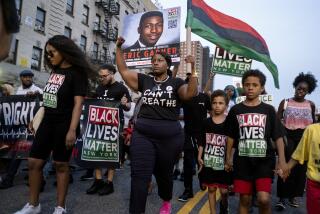Disadvantage magnifies foes, shrinks self-image, study suggests
An adversary looms larger and stronger if you’re incapacitated or off-balance, according to a study by UCLA anthropologists that places the classic “fight, flight or parley” question in an evolutionary context.
The study, part of a series that examines how humans assess potential adversaries, showed that young male participants who were restrained on a chair or who struggled to balance on a board consistently underestimated their own stature and overestimated that of an angry-looking male, compared with a control group.
The results suggest that mental tough-guy tallies are influenced by a visual shortcut that researchers believe was handed down by evolution. Men who developed an ability to visualize their relative power quickly and accurately survived encounters, while those who underestimated their adversary didn’t live to pass on their genes.
Such rapid, seemingly unconscious, assessments are vital to the U.S. military, which funded the work, but also factor into such areas as law enforcement and daily interactions. The process also touches on sensitive areas such as racial prejudice and stereotype. Skewed perceptions of relative threat were at the heart of the fatal confrontation in Florida last year between neighborhood watch volunteer George Zimmerman and teenage passerby Trayvon Martin, a racially polarizing case that ended in Zimmerman’s acquittal of second-degree murder and manslaughter.
Encounters between two strangers may rest on a metaphorical “mental picture” that can turn literal, the studies suggest.
“You have a little picture of the opponent in your head, and each time you learn something about the opponent or about yourself that’s relevant to the question of who would win a conflict, you just adjust the size of the little picture in your head,” said UCLA anthropologist Daniel M.T. Fessler, lead author of the study published online Wednesday in the journal PLOS One.
The researchers have previously shown a similar phenomenon when people viewed someone with a gun – the presence of a weapon appeared to skew perceptions of stature. And young men in a group tended to “shrink” the stature of a terrorist, in another study – a finding that parallels other work showing that male chimpanzees tend to initiate a fight when they hold a 3-to-1 advantage.
Researchers believe they are identifying a vetting process that once was focused exclusively on physical dominance, but has grown into more complex issues of social hierarchy and deference.
Fessler and his colleague, Colin Holbrook, believe evolution has selected for cautious, rapid calculators who then adapted to new circumstances.
“It’s just built on top of this old system that originally was evaluating size and strength, nothing else,” Fessler said. “So, in chickens or lizards, that’s probably all that they’re looking at. When they’re deciding do I peck or do I run, they’re just thinking about who’s bigger and who’s stronger. Natural selection just tweaked that as behavior became more complicated.”
There are detractors, however, who hold that we are born with a tabula rasa on which life and experience etches our behavior and ultimately our culture.
“I and my collaborators think that there’s a compelling case to be made that this is a part of our deeply evolved psychology, but to be fair, a skeptic could argue that developmental experience might be enough to build such a system,” Fessler said.
Animals that don’t have much social experience during development, however, demonstrate the same calculus of formidability, he said.
“It’s not clear that social experience is necessary for this system to operate,” said Fessler. “Given that size and strength matter in determining the outcome of conflicts in many, many species, we think it’s parsimonious to suggest that this is a very ancient system, and that as the behavioral repertoire becomes more complicated, as it has in our lineage, those simple dimensions become used for representing a far wider range of different contributing factors to relative formidability.”
How the study was done:
Forty-six men of an average age of about 23 were told they were to participate in a study about physical disabilities. They were strapped to immovable chairs and asked to perform random judgment tasks interspersed with the test: matching an angry face to bodies and silhouettes. They repeated the experiment unrestrained, but with small metal caps on their fingertips. Then they were asked to say when a laser pointer reached a spot that matched their standing height. Those who were restrained chose larger bodies.
In the second test, 45 men of similar age who were told they were participating in a test of motor skills performed similar tasks in a survey format, while trying to balance on a rocking disk, and while standing on the ground.
All participants also answered demographic questions and completed a fear-of-crime survey and a test of their perceived relative social status. Social power was not measured in the balance test, but participants were asked how difficult the balancing was, and primary results were analyzed only from those who rated it more than minimally difficult. Expanded analysis that included some of those who judged the task as easier produced similar results.







